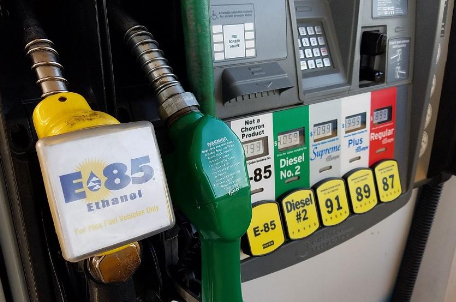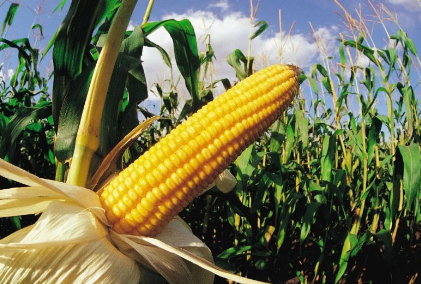Flex Fuel Vehicles

Many modern vehicle manufacturers offer models that can run on multiple fuel options, a.k.a Flex Fuel Vehicles (FFV). Flex fuel vehicles are vehicles that have engines designed to run on fuel ranging from regular gasoline to higher, ethanol content fuels like E85 and E15. How do you know if your vehicle is rated for flex fuel? Look for a yellow fuel fill cap, a yellow tag around a capless system, badges on the side of the car, or in the vehicle owner’s manual. Only run the higher ethanol content fuels in vehicles designed for flex fuel. Although most 2001 and newer vehicles can be operated safely on the low-level ethanol 87-octane fuel that contains up to 10% ethanol. Using ethanol blended fuel in older vehicles and small engines, like lawn mowers, can cause damage to some fuel system components. It is best to use non-ethanol fuels in these vehicles and equipment.
What is ethanol? Ethanol is an ethyl alcohol fuel source distilled down from mostly corn. The same corn that is used in animal feed and other products. The final distillation process yields a product that is 99.8% pure ethanol. This is mixed with gasoline to produce the gasohol blends. Most of the 85-87 octane fuel sold in the U.S. (about 98%) is 90% gasoline and 10% ethanol. A lot of fuel stations also offer a mid-grade, 88 octane, fuel that can have up to 15% ethanol blended into it. Some stations also offer E85 fuel. Which can have a mixture of anything from 51%-83% ethanol blend. Depending on geographic location and temperature conditions. E85 can only be used in vehicles rated for flex fuel consumption.
What makes an FFV different? Ethanol has a different burn rate and power output than that of gasoline. First, the vehicle fuel system must be built with components designed to hold up to contact with alcohol. Next, vehicle PCM (Powertrain Control Module) needs to know how much ethanol is in the fuel supply. Then it adjusts the spark timing and fuel injector flow to compensate for the ethanol. If this calculation is not correct, which happens on occasion, it can cause drivability and starting problems. It is also magnified by cooler, ambient temperatures. We have found that it is best to be consistent with what fuel you are using in your vehicle. Swapping back and forth from tank to tank of fuel can cause the PCM to get "confused and angry."
Benefits of using E-85 in my FFV
- Cleaner tail pipe emissions.
- Reduced cost per gallon at the fuel pump.
- Renewable, domestically produced fuel source.
- It makes Greta Thunberg happy.
Disadvantages to using E-85 in my FFV
- Reduced MPG. Sometimes up to 30% more fuel is needed to drive the same distance.
- Drivability and starting issues.
- Increased maintenance costs.
- Higher food costs due to using food sources to produce fuel.
- More energy is required to make ethanol then produced by ethanol (See article quote below)

As quoted from Cornell Chronicle article from Aug. 2001, “An acre of U.S. corn yields about 7,110 pounds of corn for processing into 328 gallons of ethanol. But planting, growing and harvesting that much corn requires about 140 gallons of fossil fuels and costs $347 per acre, according to Pimentel’s analysis. Thus, even before corn is converted to ethanol, the feedstock costs $1.05 per gallon of ethanol. The energy economics get worse at the processing plants, where the grain is crushed and fermented. As many as three distillation steps are needed to separate the 8 percent ethanol from the 92 percent water. Additional treatment and energy are required to produce the 99.8 percent pure ethanol for mixing with gasoline. Adding up the energy costs of corn production and its conversion to ethanol, 131,000 BTUs are needed to make 1 gallon of ethanol. One gallon of ethanol has an energy value of only 77,000 BTU. “Put another way,” Pimentel says, “about 70% more energy is required to produce ethanol than the energy that actually is in ethanol. Every time you make 1 gallon of ethanol, there is a net energy loss of 54,000 BTU.”” The article goes on to state, “Ethanol from corn costs about $1.74 per gallon to produce, compared with about 95 cents to produce a gallon of gasoline. “That helps explain why fossil fuels – not ethanol - are used to produce ethanol,” Pimentel says. “The growers and processors can’t afford to burn ethanol to produce ethanol. U.S. drivers couldn’t afford it, either, if it weren’t for government subsidies to artificially lower the price.””
My final thoughts. Most FFV vehicles have engines designed to operate primarily on gasoline but, have been adapted to the use of ethanol blends. The result is a loss of efficiency when using ethanol blended fuel. If the engine was designed specifically for ethanol consumption, as they are in some race cars, the power benefits are significant. In the end, the driver of the passenger vehicle does not save money by using E-85.
Aaron B.